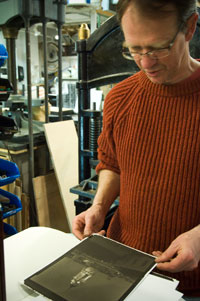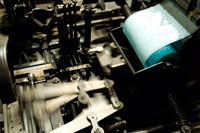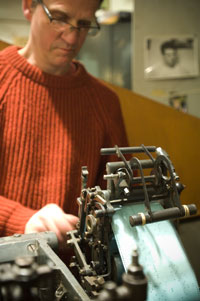The Permanence of Print
PROFILE – MAY 2008
By Joshua Bodwell
Photography Darren Setlow
An artist who brings modern sensibilities to old technology
At a time when our culture is obsessed with products and gadgetry that are light, fast, and disposable, David Wolfe has been iconoclastically creating a body of art over the past three decades that is not only heavy and slow, but permanent.
 Wolfe’s studio in Portland’s Calderwood Bakery building is the stage for, among other things, stunning letterpress printing and meticulous palladium photography. Utilizing processes that are hundreds (palladium photos) and thousands (printing from metal type) of years old, Wolfe produces contemporary art that is tinged with the mystique of antiquity. Though Wolfe’s studio brims with some quite old-fashioned equipment, it is not a museum: it is a place of action, not observation. Stacks of paper are scattered amidst the steel and cast-iron printing presses: pages of a hand-printed book about the history of port wine that are ready for the binder’s needle and thread; drying editions of woodcuts and etchings; bright posters printed from wood type; and copies of warm, brownish palladium prints. Wolfe thrives on these laborious processes, for he is an artist who embraces the journey on the way to his destination.
Wolfe’s studio in Portland’s Calderwood Bakery building is the stage for, among other things, stunning letterpress printing and meticulous palladium photography. Utilizing processes that are hundreds (palladium photos) and thousands (printing from metal type) of years old, Wolfe produces contemporary art that is tinged with the mystique of antiquity. Though Wolfe’s studio brims with some quite old-fashioned equipment, it is not a museum: it is a place of action, not observation. Stacks of paper are scattered amidst the steel and cast-iron printing presses: pages of a hand-printed book about the history of port wine that are ready for the binder’s needle and thread; drying editions of woodcuts and etchings; bright posters printed from wood type; and copies of warm, brownish palladium prints. Wolfe thrives on these laborious processes, for he is an artist who embraces the journey on the way to his destination.
Raised in New Hampshire, Wolfe arrived in Portland in 1980 after earning his BFA at the Maryland Institute College of Art. The city, he says, wasn’t overwhelmingly urban, but it still possessed the energy and culture he craved. When he began working at Portland’s renowned Anthoensen Press, letterpress printing was already being phased out by faster, cheaper offset printing. “Just in my lifetime, I have seen letterpress go from a commercial business to a fine-art niche,” says the 51-year-old Wolfe. Since 1980, however, he has made his living by printing, and in 1995 opened Wolfe Editions. In addition to printing limited-edition, hand-bound books—often on fine, handmade papers—Wolfe’s work runs to both ends of the printing gamut: from business cards and wedding invitations to fine-art editioning for acclaimed printmakers such as Leonard Baskin, Charlie Hewitt, and Michael Mazur.
Since 1997, Wolfe has also been teaching printmaking and book arts at the Maine College of Art, as well as studio workshops with his partner, Crystal Cawley. While the old-timers he learned from—unionized craftsmen who saw printing as a job, not an art form—taught him the fundamentals, Wolfe believes in doing this in addition to teaching design theory. “Getting my students working with their hands is a big part of what I do,” he says. “I get them moving physical objects, not just virtual ones, and try to convey that this can’t make the designs,” Wolfe adds, motioning to a computer. Then he circles his index finger beside his head and says, “Design happens here.” 
The book has long been at the heart of Wolfe’s design sensibility. He treats every book as a complete work of art in which text and its meaning are married with appropriate typefaces, illustrations, and binding designs. When Wolfe returned his attention to photography about seven years ago (he began art school as a photography major before shifting to printmaking), he did so with the intention of incorporating photography into his handmade books. After experimentation with other techniques, Wolfe has focused on palladium photography for the past three years. He makes his photos with a collection of wooden, bellow-style vintage cameras that feel like the photographic equivalent of his ancient printing presses—old and slow, but capable of producing work of unsurpassable quality. Wolfe’s cameras date from the 1940s and 1960s, and create negatives that range in size from 4 x 5 inches to 8 x 10 inches.
Palladium photography is more commonly known as “platinum/palladium” and dates back to 1840. Making a print requires Wolfe to draw a custom-mixed emulsion back and forth over 100-percent-cotton paper with a glass rod. After the paper is dry, it is coupled with the negative and exposed to ultraviolet light for five to ten minutes—considerably longer than the seconds it takes to develop a common silver-based print. Finally, the photo is soaked in a series of acid baths and then washed in pure water. The palladium actually binds to the cotton fibers and becomes a part of the paper. Though the process is complicated, every palladium print that Wolfe uses in his books is a one-of-a-kind piece of art, not a reproduction.
The process produces photos with a warm sepia quality and lush mid-tones. By training his antiquated lens on contemporary Portland scenes—its deteriorating commercial districts and eclectic residential neighborhoods—Wolfe’s photos crackle with a tension between old and new.
Wolfe has exhibited his books around the country and in Verona, Italy, but he has only recently begun showing his photographs. When his work caught the attention of Heather Frederick at VoxPhotographs, she immediately began representing him. With Vox handling his sales and promotion, Wolfe has the freedom to focus on what he loves most: printing.
While not every photographer enjoys the labor-intensive task of developing his or her own photos, for Wolfe it is a central part of palladium’s appeal. “I have come to realize that the making of a photo is printmaking. It’s another way,” he says humbly, “for me to get marks onto paper—and I like it when processes produce a finished piece that bare a mark of the process.”